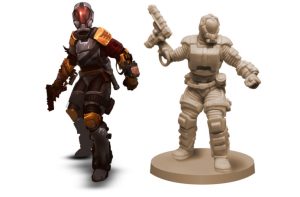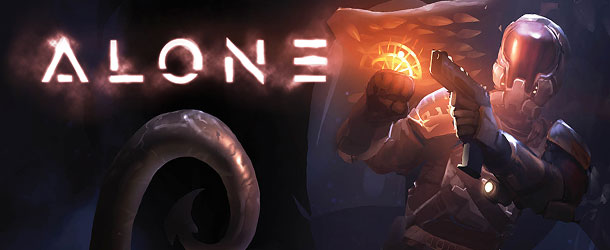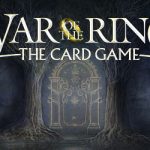Welcome to Discovering Alone*! In this series of articles, let’s take a more in-depth look at Alone, the science-fiction survival horror game designed by Andrea Crespi and Lorenzo Silva, and published by Horrible Guild. This first article presents an overview of the game, and following we will learn more about its setting, gameplay, and behind the scenes information from the game designers and the artist, Steve Hamilton.

In Alone, the Hero explores an unknown map full of traps and other dangers, while Evil masterminds plot against him.
Alone is an asymmetric dungeon crawler in which a single player will control the Hero, exploring an unknown map full of traps and other dangers, and trying to complete missions, while up to three Evil masterminds plot against him in the darkness, trying to kill him. The Hero can only see as far as his flashlight allows. Alone and abandoned, his life always threatened, he’ll have to be careful at every step. On the other side of the fence, hidden behind their screen, the Evil players can see everything. The whole map, always available to them. They can use cards to spawn and move hideous creatures as well as place insidious traps, all to make the Hero’s life as difficult as possible.
There is an overarching story in the game, spanning several scenarios. Each scenario will give the Hero missions to complete, either to gain advantages or get rid of temporary disadvantages. He has several Actions he can spend to try to get there. Whenever he moves, the Evil players will have to check the complete map and lay down the explored sectors in front of the Hero. If he enters a sector containing something nasty, he’ll take some kind of damage (be it actual damage, gameplay-altering statuses, or simply being drawn into a fight). The Hero can also spend actions to peek at sectors, forcing the Evil players to place them on the table without entering them first. But this costs him time, and time to complete the missions is limited. The Hero, being an engineer rather than a soldier, has other actions he can do, like searching for items and combining them with each other to upgrade them.
The Evil players will have to play a “wait and see” kind of game. In Alone, it is always the Hero’s turn, there is no proper “Evil turn”. What the Evil players can do is to React to the Hero’s Actions. Each Evil player has a differently themed deck of cards; they will use these cards to activate different special effects, often triggered by the Hero’s Actions. They can also discard cards (without activating their effects) to spawn/move Creatures and to place Alert tokens (which act as a sort of “trap trigger” when the Hero stumbles upon them unnoticed). By doing so, though, they will also be forced to give clues to the Hero. When a Creature or an Alert token is placed and/or moved on the map, it produces signals that the Hero’s own radar tool can intercept. This roughly translated into a “You hear a radar signal from North” warning the Evil players must give to the Hero each time they directly influence the map. By mixing these clues with his current knowledge of the map layout (and his memory), the Hero can strategically decide when it is wiser to act more carefully rather than unwarily proceeding onwards. He can also use this information to deduce the exact position of some of the impending menaces and plan his route accordingly.
In the next article, learn more about the story and setting of Alone. Stay tuned!
Next articles: The World of Alone, Designers' Diary, Hero Gameplay, Evil Gameplay, The Art of Alone
* "Discovering Alone" articles were originally published during the first game's Kickstarter project, by Horrible Guild's team.












